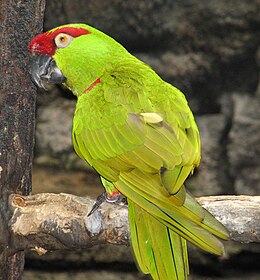Rhynchopsitta
| Thick-billed parrot | |
|---|---|

| |
| Adult Cincinnati Zoo , US
| |
| Scientific classification | |
| Domain: | Eukaryota |
| Kingdom: | Animalia |
| Phylum: | Chordata |
| Class: | Aves |
| Order: | Psittaciformes |
| Family: | Psittacidae |
| Tribe: | Arini |
| Genus: | Rhynchopsitta Bonaparte, 1854 |
| Type species | |
| Macrocercus pachyrhynchus[1] Swainson, 1827
| |
| Species | |
|
| |
The thick-billed parrots are stocky brilliant green Neotropical parrots with heavy black beaks of genus Rhynchopsitta of thick billed macaw-like parrots. The genus comprises two extant species, the thick-billed parrot and the maroon-fronted parrot, as well as an extinct species from the Late Pleistocene in Mexico. The two extant taxa were formerly considered conspecific; they have become rare and are restricted to a few small areas in northern Mexico. The range of the thick-billed parrot formerly extended into the southwestern United States; attempts at reintroduction have been unsuccessful so far.
Description
The two living species have a similar overall appearance, the principal differences lying in their relative sizes and brightness of coloration. Both are mainly green, with red or maroon markings on the forehead, forecrown, broad superciliary stripe, and
Taxonomy
The genus was described by French naturalist Charles Lucien Bonaparte; the name is derived from the Ancient Greek terms rhynchos "beak", and psitta "parrot". The two extant taxa were considered subspecies of a single species,[5] before being split.[6]
- Rhynchopsitta Bonaparte, 1854
- Rhynchopsitta pachyrhyncha (Swainson, 1827) (thick-billed parrot)
- Rhynchopsitta terrisi Moore, 1947 (maroon-fronted parrot)
- †Rhynchopsitta phillipsi Rea, 1997 - extinct
Rhynchopsitta phillipsi, a larger prehistoric relative, was described from
Ecology
Both extant species are found at heights of between 1500 and 3000 m
Status
Both the thick-billed and the maroon-fronted parrot are classified as endangered by the International Union for Conservation of Nature. They are listed on CITES Appendix I, trade forbidden except for legitimate conservation, scientific or educational purposes. They are also protected under Mexican General Wildlife Law (2008), import and export prohibited. The populations of both species have declined primarily due to habitat degradation, and now both are restricted to a few small areas in the mountains of northern Mexico.[12][13] The range of the thick-billed parrot formerly extended into Arizona and New Mexico, and attempts are being made to breed the species in captivity for release into the wild in their former range their.[11][13] An earlier attempt in the 1980s and 1990s to reintroduce thick-billed parrots to Arizona failed because the captive-bred birds had not learned to avoid their natural and human predators,[14] but new plans for the reintroduction of this species include the use of wild-caught individuals.[15]
Species
| Common name | Scientific name and subspecies | Range | Size and ecology | IUCN status and estimated population |
|---|---|---|---|---|
| Thick-billed parrot | Rhynchopsitta pachyrhyncha (Swainson, 1827) |
Sierra Madre Occidental in Mexico (and reintroduced to the U.S.)[13]
|
Size: A mostly green medium-sized parrot, 38 cm (15 in) long. Adults have a large black bill. a red brow, amber irises, red at the bend of the wings, and red thighs. Juveniles have brown irises and a pale peak. The under-wings and tail appear blackish.[3] Habitat: Diet: |
EN
|
| Maroon-fronted parrot | Rhynchopsitta terrisi R.T. Moore, 1947 |
Sierra Madre Oriental in Mexico[12]
|
Size: A large mostly green parrot about 40 cm (16 in) to 45 cm (18 in) long. The adults have a dark maroon brow which extends over the rim of bare yellow skin that surrounds the eyes. They have a brighter red at the bend of the wing. The tail is long and pointed. The underside of the wings are blackish.[4] Habitat: Diet: |
EN
|
Fossils
| Species | |||
|---|---|---|---|
| Common and binomial names[6] | Image | Description | Range |
| †Rhynchopsitta phillipsi | Large parrot with a distinct bill shape | Late Pleistocene fossils of the extinct parrot have been found in Mexico. | |
References
- ^ "Psittacidae". aviansystematics.org. The Trust for Avian Systematics. Retrieved 2023-07-24.
- ISBN 0-691-09251-6.
- ^ a b c d Thick-billed Parrot - BirdLife Species Factsheet
- ^ a b c d Maroon-fronted Parrot - BirdLife Species Factsheet.
- ^ ISBN 0-7153-7698-5.
- ^ a b "Zoological Nomenclature Resource: Psittaciformes (Version 9.020)". www.zoonomen.net. 2009-03-01.
- ^ Rea, A.M. (1997). The indeterminate parrot of Nuevo Leon. The era of Alan R. Phillips: A festschrift. Albuquerque, NM: Horizon. pp. 167–176.
- ^ Arroyo-Cabrales, Joaquín; Johnson, Eileen (2003). "Catálogo de los ejemplares tipo procedentes de la Cueva de San Josecito, Nuevo León, México" (PDF). Revista Mexicana de Ciencias Geológicas. 20 (1): 79–93.
- ^ ISBN 978-0-8138-2749-0.
- ^ a b c d "Birds: Thick-billed Parrot". San Diego Zoo's Animals Bytes. Retrieved 2009-03-07.
- ^ a b Snyder, N. F.; E. C. Enkerlin-Hoeflich; M. A. Cruz-Nieto (1999). A. Poole (ed.). "Thick-billed Parrot (Rhynchopsitta pachyrhyncha)". The Birds of North America Online. Ithaca: Cornell Lab of Ornithology. Retrieved 2009-03-07.
- ^ . Retrieved 12 November 2021.
- ^ . Retrieved 12 November 2021.
- ^ "New reserve offers hope for reintroduction of Thick-billed Parrots to the US". Birdwatch. Solo Publishing Ltd. 24 November 2008. Archived from the original on 29 January 2010. Retrieved 2009-03-07.
- PMID 22307993.


